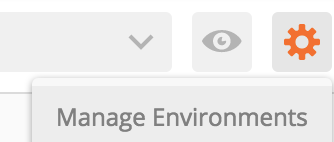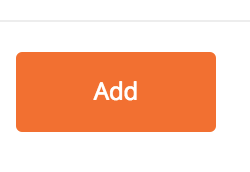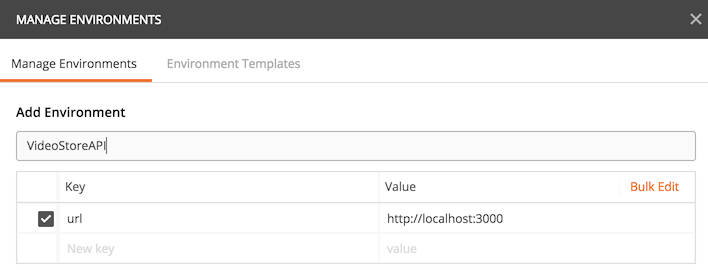The goal of this project is to create a system that a video store (remember those?) could use to track their inventory of rental videos and their list of customers.
We will use Rails to construct a RESTful API. The purpose of this API is to quickly serve information about the store's video collection, customer information, and to update rental status. This repository provides two JSON datafiles to serve as the initial seeds for this system.
This is a pair project. You and your partner should use all the techniques we've learned so far to keep yourselves organized and on track, and ensure that no requirements slip through the cracks.
This project is due: Friday May 17th
Upon completing this project, students should be able to:
- Build an ERD and set up ActiveRecord models for a given dataset / use-case
- Expose database contents through a web API
- Respond reasonably to bad user data in the context of an API
- Verify the correctness of an API using controller tests
This is a stage 2 project.
Your project will be evaluated against the following requirements:
- API conformity
- The provided smoke tests should pass (see the subfolder)
- Bad data sent to the API should result in an appropriate status code and helpful error
- Test coverage
- Models: All relations, validations, and custom model methods should include at least one positive and one negative test case
- Controllers: Every API endpoint should include at least one positive and one negative test case
- Style and Organization
- Everything we've learned so far about how to design and build a Rails app still applies!
- Read the API Requirements below and create a pseudo-code "routes" file that specifies
- The endpoints your API will need
- The HTTP verbs each endpoint will use
- Any data that must be provided to the endpoint in order for it to do its work
- Read the Seed Data description below and, bearing in mind the API Requirements, create an ERD for your database that specifies
- The models your database will require
- The attributes for each model
- Any relationships between models
- Create a new Rails app to serve as the API
- Create the rails app with:
$ rails new . --api
- Create the rails app with:
- Create a route that responds to
/zomgthat serves a json-encoded "it works!"
- Generate Rails models and associations to match your ERD
- Use the provided seed script
db/seeds.rbto import the provided JSON data into your database
In the past, many students have spent lots of time writing and testing validations for these models. Because project time is limited and validations are not an important learning objective this week, we do not recommend this. Instead, validate only those fields that, if they are absent, will break your API.
movies.json contains information about the videos available to rent at the store. The data is presented as an array of objects, with each object having the following key-value pairs:
| Field | Datatype | Description |
|---|---|---|
title |
string | The title of the film |
overview |
string | A short plot synopsis |
release_date |
date | YYYY-MM-DD, Day the film was originally released |
inventory |
integer | How many copies of the film the video store owns |
customers.json contains information about the customers that have rented with the store in the past. The data is presented as, you guessed it, an array of objects, with each object have the following key-value pairs:
| Field | Datatype | Description |
|---|---|---|
name |
string | The customer's name |
registered_at |
datetime | Wed, 29 Apr 2015 07:54:14 -0700, When the customer first visited the store |
address |
string | Street address |
city |
string | |
state |
string | |
postal_code |
string | |
phone |
string | Primary contact phone number |
As with all Rails projects, model testing is a requirement. You should have at least one positive and one negative test case for each relation, validation, and custom function you add to your models.
Use good TDD practices, and test before you code. Remember: red-green-refactor.
In this wave, you will implement the API described below. The endpoints are described more-or-less in order of complexity, and we recommend you build them in that order. Every endpoint must serve JSON data, and must use HTTP response codes to indicate the status of the request.
The schema of your database and the structure of your rails app are completely up to you, so long as the API conforms to the description and provided script.
If something goes wrong, your API should return an appropriate HTTP status code, as well as a list of errors. The list should be formatted like this:
{
"errors": {
"title": ["Movie 'Revenge of the Gnomes' not found"]
}
}All errors your API can return should be covered by at least one test case.
Because APIs are often open to the public, thorough testing is essential. For a Rails API, that means controller testing.
For each API endpoint, you should have at least:
- A basic test with no parameters, if applicable
- Positive and negative tests for any URI parameters (user ID, movie title)
- Testing around any data in the request body
Use good TDD practices, and test before you code. Remember: red-green-refactor.
Because this API will be used as the backend for a future project, there are strict requirements about how it should be structured. To this end, we have provided a set of smoke tests written in Postman to exercise all the endpoints.
The smoke tests will verify that your API looks correct to the outside world, by sending actual HTTP requests to your running server and checking the results. They test things like:
- Did I get a success response for a valid request?
- Did the API return JSON?
- Does the JSON contain the expected property names?
We have also included this video to show you how to run and use smoke tests.
The smoke tests are not a substitute for writing your own tests!!!!! They do not check that the content is correct, nor do they cover any negative or edge cases. Verifying correctness in these cases is your responsibility.
The smoke tests live in the file test/VideoStoreAPI_smoke_tests.postman_collection.json. To run them:
- Open Postman
- Click
Importin the top left - Drag-and-drop the file into the box
- In the left sidebar, click on the
Collectionstab - There should now be an entry for the smoke tests. Hover over it and click the
>icon for a detail view. You will notice they are in the format{{url}}/movies.{{url}}is a key which you can give a value on your computer. - To do so go to the Gearbox in the top-right and select
Manage Environments
- Then Select
Add
- Lastly add a key
urland valuehttp://localhost:3000
- Click the blue
Runbutton. This will launch the collection runner. - In the collection runner, scroll down in the center pane and click the blue
Start Testbutton
List all customers
Fields to return:
idnameregistered_atpostal_codephonemovies_checked_out_count- This will be 0 unless you've completed optional requirements
List all movies
Fields to return:
idtitlerelease_date
Look a movie up by id
URI parameters:
id: Movie identifier
Fields to return:
titleoverviewrelease_dateinventory(total)available_inventory(not currently checked-out to a customer)- This will be the same as
inventoryunless you've completed the optional endpoints.
- This will be the same as
Create a new movie in the video store inventory.
Upon success, this request should return the id of the movie created.
Request body:
| Field | Datatype | Description |
|---|---|---|
title |
string | Title of the movie |
overview |
string | Descriptive summary of the movie |
release_date |
string YYYY-MM-DD |
Date the movie was released |
inventory |
integer | Quantity available in the video store |
Wave 2 focused on working with customers and movies. With these endpoints you can extend the functionality of your API to allow managing the rental process.
Check out one of the movie's inventory to the customer. The rental's check-out date should be set to today, and the due date should be set to a week from today.
Note: Some of the fields from wave 2 should now have interesting values. Good thing you wrote tests for them, right... right?
Request body:
| Field | Datatype | Description |
|---|---|---|
customer_id |
integer | ID of the customer checking out this film |
movie_id |
integer | ID of the movie to be checked out |
Check in one of a customer's rentals
Request body:
| Field | Datatype | Description |
|---|---|---|
customer_id |
integer | ID of the customer checking in this film |
movie_id |
integer | ID of the movie to be checked in |
These really are optional - if you've gotten here and you have time left, that means you're moving speedy fast!
Any endpoint that returns a list should accept 3 optional query parameters:
| Name | Value | Description |
|---|---|---|
sort |
string | Sort objects by this field, in ascending order |
n |
integer | Number of responses to return per page |
p |
integer | Page of responses to return |
So, for an API endpoint like GET /customers, the following requests should be valid:
GET /customers: All customers, sorted by IDGET /customers?sort=name: All customers, sorted by nameGET /customers?n=10&p=2: Customers 11-20, sorted by IDGET /customers?sort=name&n=10&p=2: Customers 11-20, sorted by name
Of course, adding new features means you should be adding new controller tests to verify them.
Things to note:
- Sorting by ID is the rails default
- Possible sort fields:
- Customers can be sorted by
name,registered_atandpostal_code - Movies can be sorted by
titleandrelease_date - Overdue rentals can be sorted by
title,name,checkout_dateanddue_date
- Customers can be sorted by
- If the client requests both sorting and pagination, pagination should be relative to the sorted order
- Check out the will_paginate gem
All these endpoints should support all 3 query parameters. All fields are sortable.
List all customers with overdue movies
Fields to return:
movie_idtitlecustomer_idnamepostal_codecheckout_datedue_date
List customers that have currently checked out a copy of the film
URI parameters:
id: Movie identifier
Fields to return:
customer_idnamepostal_codecheckout_datedue_date
List customers that have checked out a copy of the film in the past
URI parameters:
id: Movie identifier
Fields to return:
customer_idnamepostal_codecheckout_datedue_date
List the movies a customer currently has checked out
URI parameters:
id: Customer ID
Fields to return:
titlecheckout_datedue_date
List the movies a customer has checked out in the past
URI parameters:
id: Customer ID
Fields to return:
titlecheckout_datedue_date
Check the feedback template to see how we will evaluate your project.